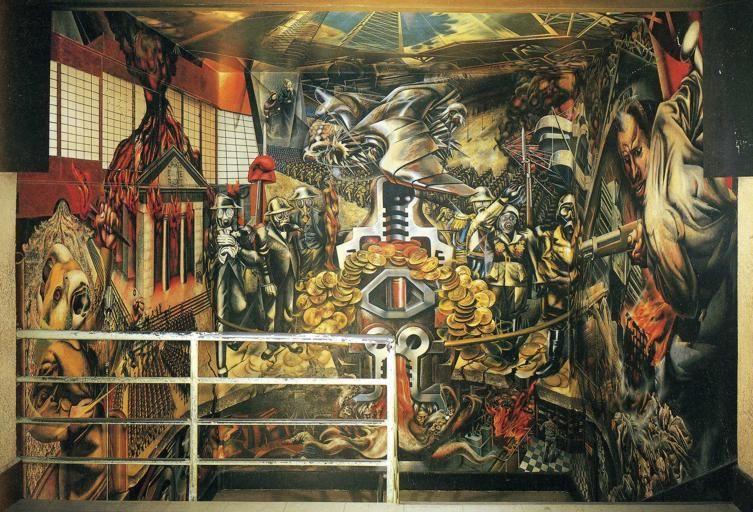At the “Theory Talks” Blog, there is an excellent interview with Michael J. Shapiro on “Pictures, Paintings, Power and the Political Philosophy of International Relations.” Shapiro argues for the need to awaken the discipline from its pre-Kantian slumber and to move beyond the “anemic, empiricist philosophy of social science which treats mere appearances” as well as the “security-minded and war strategy focused” versions of international relations. Instead of working within the established techniques of the discipline, Shapiro embraces alternative genres (e.g. film, architecture, poetry, music, etc.) to illuminate hidden political partitions and to articulate alternate possible worlds.
On reading Shapiro’s comments, I began to think about my favorite political paintings and pictures. For my political economy courses, my favorite image is David Alfaro Siqueiros’ mural “Portrait of the Bourgeoisie,” (1939). A segment of the mural was used as the cover of Atul Kohli’s State Directed Development (2004), which I assign in my advanced course on States and Markets. I have found that a discussion of the mural is often a compelling way of reviewing and critiquing corporatist models of development with my students.
 |
|
Image Source: https://www.abcgallery.com/S/siqueiros/siqueiros9.html
|
Another favorite image, that I use in my seminar on “Sovereign and Subaltern” is a photo of a US soldier collecting biometric data from an elderly Afghan man in 2008. The image captures the obsessive and largely unchallenged attempt by the United States to assemble a biometric archive of the entire population of Iraq and Afghanistan. The project is reminiscent of Britain’s attempt to develop a systematic fingerprint archive of Indians one year after the Sepoy Mutiny / First War of Independence in 1857. These projects reveal not only the operation of power/knowledge, but also the pervasive fears of the “duplicitous” oriental subject that inform imperial practices in occupied territories. Of course, the invention and deployment of these disciplinary technologies on a subject population, whether fingerprinting or iris scanning, inevitably find their way from the periphery to the metropole. Hence, the photo reminds us that the conquered territory / colony is a laboratory for the refinement of disciplinary technologies. In this respect, the periphery may be the future of the core.
 |
| Image Source: AP Photo/Rafiq Maqbool. |
I am curious as to what the other Ducks would list as their favorite political/social paintings or pictures…
Vikash is an Associate Professor of Political Science and Asian Studies at Hobart and William Smith Colleges in Geneva, NY. His main areas of academic interest are (post-) globalization, economic development, and economic freedom, with a regional focus on South Asia


0 Comments